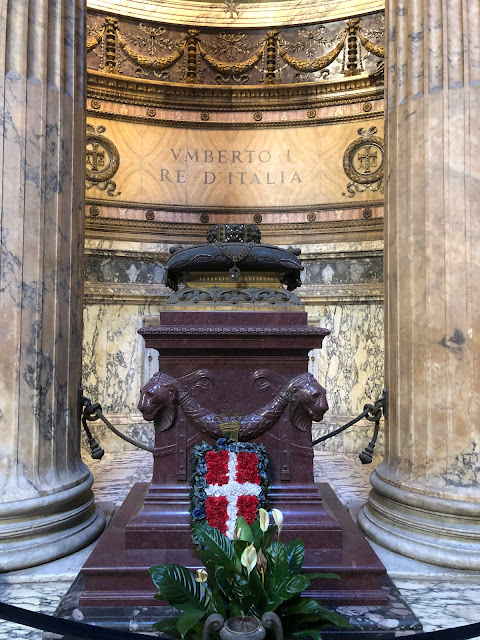古代ローマの時代は、あらゆる神々のための神殿だったというパンテオン。その後、キリスト教がローマ帝国の国教になると、ここは聖母と殉教者を祀る教会となった。
ルネサンス期以降は、この場所は、ローマにゆかりの人々が埋葬される場所になっている。
The Pantheon is said to have been a temple for all gods in ancient Roman times. Later, when Christianity became the state religion of the Roman Empire, it became a church dedicated to Our Lady and Martyrs.
Since the Renaissance, this place has been the place where people associated with Rome are buried.

パンテオンを入って、左手のほぼ中央付近に、ラファエロの墓がある。
ラファエロは、同郷のブラマンテの推薦もあり、ローマ教皇やローマの有力者たちのために、このローマの地で忙しく制作活動を行なっていた1520年4月6日にわずか37歳で亡くなった。
その遺骨は、本人の遺言によりこのパンテオンに埋葬された。
墓石の上の部分には、ピエトロ・べンボによる哀悼紙が刻まれている。
ピエトロ・べンボは、ラファエロと同時代の詩人で、人文学者でもあり枢機卿でもあった。
ヴェネツィア生まれだが、フィレンツェで幼少期を過ごしたべンボは、後年になってフィレンツェの方言がイタリア文学全体に大きな影響を与える、その原動力になった。
ラファエロが描いた若き日のピエトロ・べンボの肖像画が残されている。
Entering the Pantheon, there is Raphael's tomb near the center on the left.
Raphael died at the age of only 37 on April 6, 1520, when he was busy working in the Roman land for the Pope and the Roman influential people, at the recommendation of his native Bramante.
His remains of him were buried in this Pantheon by his own will.
The upper part of his tombstone is engraved with a memorial paper by Pietro Benbo.
Pietro Benbo was a poet, humanist and cardinal of the same era as Raphael.
Born in Venice, but spent his childhood in Florence, Benbo later became the driving force behind the great influence of the Florentine dialect on Italian literature as a whole.
A portrait of young Pietro Benbo by Raphael is preserved.
その墓の上には、ロレンツェットの聖母子像が置かれている。
ラファエロが遺言で依頼していたもので、ロレンツェットは古代のヴィーナスの彫像をモデルにして、この聖母子像を作ったという。
ラファエロと言えば、聖母子像の画家というイメージが強いが、本人も後世の人々に自分をそう見て欲しかったのだろうか。
確かにラファエロは多くの聖母子像を描いたが、それ以外にもヴァチカン宮殿の壁画や、多くの肖像画作品を残している。
ラファエロの描いた作品は版画化されて、ルネサンス文化に憧れるヨーロッパ各地に広まり、ラファエロをルネサンスを代表する画家として位置つけることになった。
今回の旅の中で、フィレンツェのピッティ宮殿やウフィツィ美術館、そしてこのローマのヴァチカン美術館などで多くのラファエロの作品を目にしてきた。
ラファエロの墓を前にして、わずか37年という生涯の中で成し遂げたことのあまりの偉大さに、改めてその存在がまさに奇跡であったことを実感した。
Above the tomb is a statue of the Madonna and Child of Lorenzetto.
At the request of Raphael in his will, Lorenzetto is said to have created this Madonna and Child statue, modeled after an ancient statue of Venus.
Speaking of Raphael, he has a strong image of being a painter of the Madonna and Child, but did he want posterity to see himself that way?
Sure, Raphael painted many Madonna and Child statues, but he also left behind mural paintings at the Vatican Palace and many portraits.
Raphael's works were made into prints and spread throughout Europe, where he admired Renaissance culture, and Raphael was positioned as a representative painter of the Renaissance.
During his journey, he has seen many of Raphael's works at the Pitti Palace in Florence, the Uffizi Gallery, and the Vatican Museums in Rome.
In front of Raphael's tomb, I once again realized that his existence was a miracle, to the greatness of what he had accomplished in his life of only 37 years.
ラファエロの墓のちょうど反対側にあたる場所に、ヴィットリオ・エマヌエーレ2世の墓がある。
ヴィットリオ・エマヌエーレ2世は、トリノでサヴォイア家に生まれ、その後サルディーナ王国の国王になった。
時代はまさにリソルジメント、イタリア統一運動の時期にあたり、その運動を主導したヴィットリオ・エマヌエーレ2世はイタリア王国の初代国王にもなった。
リソルジメントについては、これからのこの旅の中で、度々触れていくことになるだろう。
Just opposite Raphael's tomb is the tomb of Vittorio Emanuele II.
Vittorio Emanuele II was born to the Savoia family in Turin and later became king of the Kingdom of Sardina.
His time was exactly the time of the Resorgimento, the Unification of Italy, and Vittorio Emanuele II, who led the movement, became the first king of the Kingdom of Italy.
Resorgiment will be mentioned frequently in this journey.
ラファエロの墓のすぐ左隣に、ウンベルト1世の墓がある。
ウンベルト1世はヴィットリオ・エマヌエーレ2世の子で、イタリア王国の2代目の国王だった。
統一後の混乱の時期にあって、ウンベルト1世は無政府主義者の銃弾によって命を落とした。
イタリアは、その後王政が廃止されてしまったので、このパンテオンに埋葬されたイタリア国王は、ヴィットリオ・エマヌエーレ2世とウンベルト1世の2人だけだった。
To the immediate left of Raphael's tomb is the tomb of Umberto I.
Umberto I was the son of Vittorio Emanuele II and the second king of the Kingdom of Italy.
During the post-unification turmoil, Umberto I was killed by anarchist ammunition.
Since Italy's royal government was abolished after that, the only two Italian kings buried in the Pantheon were Vittorio Emanuele II and Umberto I.
パンテオンの中から出ようとした時に、入り口のすぐ左手に受胎告知のフレスコ画が目に入った。
これは、15世紀に活躍したメロッツォ・ダ・フォルリによる作品で、どこか、フラ・アンジェリコの受胎告知を連想させる。
メロッツォ・ダ・フォルリは、マンテーニャやピエロ・デラ・フランチェスカなどの影響を受けた画家で、ウルビーノのフェデリコ・デ・モンテフェルトロ公に使えていた。
その後、ローマに来て、シクストゥス4世の元で多くの作品を残した、ルネサンスの巨匠の一人だ。
パンテオンは、古代ローマの時代にあらゆる神々を祀る場所として作られたが、現在では美の殿堂という側面も持っているようだ。
As I tried to get out of the Pantheon, I saw a fresco of the Annunciation on the left side of the entrance.
This is a work by Melozzo da Forli, who was active in the 15th century, and is somewhat reminiscent of Fra Angelico's Annunciation.
Melozzo da Forli was a painter influenced by Mantegna and Piero della Francesca, and was used by Prince Federico de Montefertro of Urbino.
Later, he came to Rome and was one of the Renaissance masters who left many works under Pope Sixtus IV.
The Pantheon was created in ancient Roman times as a place to worship all gods, but now it seems to have the aspect of a beauty hall of fame.








コメント
コメントを投稿